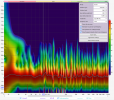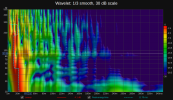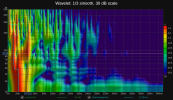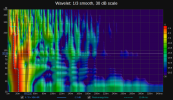Skimmed some of it… sorry, but I haven’t looked too deeply at your workflow.
I would prefer seeing the before and after mdat measurements including the filter. An actual in-room measurement for extra “verification” would be even better.
I tried to make an example for you the other day but came across an issue. I hadn't saved an mdat with my VBA tests in it, but I still had the IR WAV file. So I imported the IR and multiplied it against the old measurements, but only the SPL graph would generate, and none of the timing ones. So no Spectrogram. I don't know why that would be?
Instead I set about recreating the IR from memory (the delay being the part to remember). I applied it to the cancellation.mdat you uploaded, and the results were similar to your EQ method on the Spectrogram. However, I noticed your mdat must have been an older copy of OCA's that I too was testing against, but your one had lower test SPL. This meant the decay quickly dropped off on the quieter spectrogram, because it was quieter to begin with. When I applied it to the louder test, the improvements were greater. However, the improvements were still only after ~150ms at these low frequencies, presumably because it takes time for the VBA wave (as tested, still work in progress) to propagate through the room and do its thing.
So just now I've gone and done a quick trial run with my own measurements. My left speaker has 2 "back wall" reflections due to an odd room shape, and this problem appears at ~80Hz and ~160Hz. So I decided to set my band pass in the middle (120Hz), and I did 1 octave either side at 24dB/oct, this way the "smearing" of the filter was less (and hopefully any cancellation would be over a wider freq range). My first attempt with 26ms inverted -6dB impulse is below and attached. This was literally my first test after using Audacity to set the delay to a suitable time to show any improvement, so is far from optimal.


Still the VBA killed all the very late noise, but hasn't done a lot between say 100 and 350ms. It has made a small improvement in that range if you look closely through, also evident in the below screenshot. But where it's really made an improvement (according to simulations) is longer sustained tones, because like I've said before, REW doesn't actually show the SPL of these. Because when I simulate a long tone of 82Hz, before it would constantly increase in volume, whereas with VBA it is tamed at a relatively constant level. You can't get that performance with a plain old PEQ, because that just turns down the initial wave, and then the volume creeps up over consistent waves. Once again with VBA I've shown that it effectively lets the first wave be full volume, then EQ's down the volume of subsequent waves to keep the SPL steady.

Edit: Just for further info, I've realised my ~80Hz room issue is quite strange. I'm not yet sure if its because of my speaker locations (SBIR etc) or being nearfield etc, OR if it is in fact the "double back wall" relfections, but there is a phase shift in the reflections. When I'm trying to overlay a VBA wave, they keep moving on each other. I may need 2 VBA waves...
Edit: BTW, this "82Hz in room" looks different to the above "82Hz room" because I copied that above and applied additional bandpass. I did this because the rooms IR (and thus the room) adds noise that I don't want to see. This extra bandpass "adds delay", but it's equal in both samples below and thus inconsequential to working out my VBA delay.

 www.audiosciencereview.com
www.audiosciencereview.com














